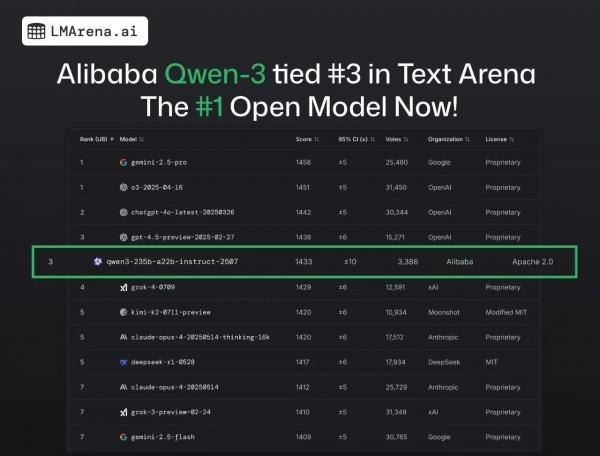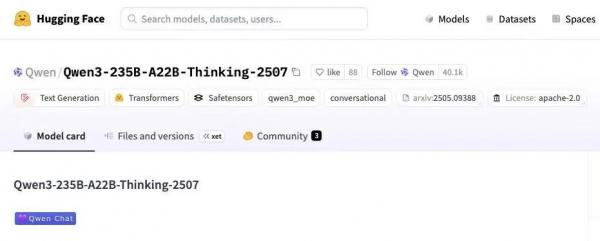Ali Scales Up Its Open-Source Efforts
![]() 08/22 2025
08/22 2025
![]() 626
626

Ali's open-source endeavors are scaling up even further!
Text | Huashang Taolue, Lin Lan
On August 2, Chatbot Arena, a globally authoritative ranking for large models, released its latest list.
On the overall leaderboard, Ali's newly launched language large model, Qwen3-235B-A22B-Instruct-2507, which debuted on July 22, ranks third globally with a score of 1433.

▲Source: Tongyi Qianwen Qwen
This score sets a new all-time high for globally open-source large models on this leaderboard and marks the highest score ever achieved by a Chinese large model.
Additionally, Qwen3-235B-A22B-Instruct-2507 tops the rankings in five key capabilities: mathematics, coding, complex prompts, long text retrieval, and instruction following.
Furthermore, Qwen3-Coder-480B-A35B-Instruct, an AI programming large model open-sourced by Ali almost simultaneously, ties for first place globally with Gemini2.5 Pro, DeepSeek-R1, and Claude4 on the programming capability sub-leaderboard.
[01 Open Sourcing: Embracing an Internet-Like Large Model]
How powerful are Ali's above models?
Take Qwen3-235B-A22B-Instruct-2507, for instance. In practical applications for batch analysis of e-commerce product reviews, it can achieve precise identification and computational processing, reducing the manual tagging task that originally required 2 hours to just 5 minutes, with "fully usable data quality".
The AI programming large model, Qwen3-Coder-480B-A35B-Instruct, is considered more "understanding" than Gemini2.5 Pro, DeepSeek-R1, and Claude4, and is powerful enough to build a warehouse logistics management system with just three "plain language" (natural language) instructions.
All these models are open-sourced under the permissive Apache 2.0 license, allowing anyone to view and use their source code and apply them commercially in various scenarios for free.

▲Screenshot of Qwen3-235B-A22B-Thinking-2507 open source page Source: Zhidongxi
Open sourcing was a fundamental principle set by Ali even before the launch of the Tongyi Qianwen Qwen large model in 2023.
At that time, large models were completely closed-source—well-known models like Google DeepMind's Gemini, Anthropic's Claude, and Baidu's Wenxin Yiyan in China were all closed-source.
Even GPT, which was originally intended to be open-source under OpenAI, switched to closed-source. Closed-source allows users to become paid members, with a clear commercialization path.
Even Llama (produced by Meta), which was touted as open-source at the time, only made the model itself publicly available and did not disclose training code, training data, etc., requiring it to be used only for research and not for commercial purposes, which was dubbed "fake open source" by the industry.
However, Ali firmly chose open sourcing because openness and open sourcing have long been the core spirit and gene of Ali in technological innovation and development.
"Wu Ma, we've done a lot of things, and what we've done is pretty good, with technical depth and challenges. How about open sourcing? Let the outside world understand us better," said Zhang Wensong, then the senior technical director of Taobao, to Wu Yongming, then the senior vice president of the Ali Group, in 2010.
Zhang Wensong, a renowned open-source evangelist, created the LVS (Linux Virtual Server) open-source software during his PhD, which already enjoyed a reputation in the industry.
Wu Yongming's response was straightforward: "Then you start doing it."
Zhang Wensong then initiated Ali's open-source journey with specific projects. Since then, Ali's open-source actions have become increasingly systematic—establishing an open-source committee, having open-source processes, and using open-source achievements as one of the bonus points for annual job level evaluations.
From then on, open sourcing became a tradition ingrained in Ali's DNA.
Even when someone suggested in 2015 that competitors were using Ali's open-source software to accelerate their R&D, and despite the fact that the initiator Zhang Wensong later left Ali, this tradition did not change.
This is also a concrete manifestation of Jack Ma's chivalrous sentiments and part of the core of the internet spirit that should exist—all for one, one for all.
As we enter the era of large models, the internet is increasingly becoming an infrastructure like water and electricity, but it is increasingly difficult to hear the term "internet spirit" mentioned again. Ali has once again raised this banner.
Alibaba Cloud CTO Zhou Jingren mentioned in an interview that Ali's vision is to "make it easy to do business anywhere," and Alibaba Cloud's original intention is to "enable enterprises to efficiently realize technological and business innovation on the cloud," while open-source large models are "hoping to make it easier for enterprises to apply large models to their businesses." These three visions are "highly consistent and in the same line of inheritance".
Wu Yongming, the current CEO of Alibaba Group, also emphasized at the 2024 World Internet Conference that Alibaba will adhere to open sourcing and opening up to the world, transforming AI capabilities into productivity across thousands of industries.
True openness and free access have laid a foundation for Qwen to catch up. Despite starting relatively late in the field of large models, Ali has achieved global leadership amidst strong competitors. Another important secret is the diligence inherited from Alibaba Cloud—diligent and fast, iterating rapidly.
Some even say that the iteration of Ali's Tongyi Qianwen large model is so fast that it overwhelms Llama, which also touts open sourcing—for example, within less than three months after the release of the first Qwen3 model, several new models were added to the Qwen series, refreshing the state-of-the-art (SOTA) several times.
In August 2023, the first open-source model of the Qwen series, Qwen-7B, was quietly released. In June 2024, Qwen2-72B surpassed the once strongest open-source Llama series in over a dozen international authoritative evaluations. Now, Qwen3 has repeatedly set new performance highs for all domestic models and globally open-source models.
In just two years, open-source Qwen has come a long way.
[02 Free: A Bigger Business Strategy]
Qwen's open sourcing and free access are not just for the sake of spirit but also for business.
Its model is similar to the internet's approach of first "attracting traffic" and then "monetizing"—by open sourcing, more users are attracted to use the Qwen series of large models. During user usage, especially for enterprise users, they often need to purchase supporting cloud products such as databases, storage, networking, security, etc.—and these are precisely the core businesses and strengths of Alibaba Cloud, the largest cloud vendor in the Asia-Pacific region.
By driving users through open-source large models and then promoting Alibaba Cloud's business through these users, Ali's strategy has already proven successful.
Now, Ali has open-sourced hundreds of large models. There are over 140,000 Qwen derivative models in domestic and overseas open-source communities, with downloads exceeding 400 million. This makes Qwen surpass Meta's Llama and become the world's most used open-source model family.
The increasing number of users from various industries can not only bring business growth opportunities for Alibaba Cloud but can also provide feedback for the optimization of large models through application practice, thereby attracting more users. Ali's "model-cloud-industry application" flywheel thus spins rapidly.
This has also been verified in Ali's financial report—in the fourth quarter of fiscal year 2025, Alibaba Cloud's revenue was 30.127 billion yuan, a year-on-year increase of 18%, the fastest growth rate in three years. Among them, the year-on-year growth of AI-related products has maintained triple digits for seven consecutive quarters.

As the business develops, the driving effect of Ali's large models on the cloud business will continue to strengthen.
For example, Ali's recent efforts in programming large models represented by Qwen3-Coder are inherently "lucrative"—the generation and optimization of code consume a lot of computing resources, thereby driving the cloud business.
This is even more significant amid the current explosion of AI agents and the surge in demand for AI programming.
For instance, Anthropic's AI programming model Claude Code, which was just opened for use in May this year, currently has an annualized revenue of over US$200 million, making a fortune. And Qwen3-Coder's performance and user experience are not inferior, with even higher cost-effectiveness.
Therefore, some industry insiders have pointed out that Qwen3-Coder will vigorously compete for Claude 4's global market share. And Ali's goal in the field of programming large models is probably also to seize the high ground of commercial value and ecological potential through open sourcing as the Agent era approaches.
[03 Openness: A Path to Breakthrough and Leadership]
Currently, the two most influential large models in China globally can be said to be DeepSeek and Qwen. Both rank in the top five on the Chatbot Arena overall leaderboard this time.
DeepSeek and Qwen have different development paths. The former focuses more on Chinese and English text reasoning, while the latter pays more attention to multi-size, multi-language, multi-modal, and Agent adaptation. But they share a common feature: open source.
Liang Wenfeng, the founder of DeepSeek, said in an interview in 2024: "China's AI cannot always be a follower... If this doesn't change, China will forever only be chasing others, not leading the way."
Joseph C. Tsai, Chairman of the Alibaba Group Board of Directors, mentioned at the 2023 Cloud Town Conference: "We firmly believe that without openness, there is no ecosystem, and without an ecosystem, there is no future... We must always climb the peak of technology, and only by standing on more advanced and stable technological capabilities can we have greater confidence in openness."
Currently, open sourcing is also the preferred path to support the realization of these goals.
At present, China's large models still have a certain gap with the United States and are threatened by US suppression and sanctions.
For example, underlying technologies widely used in the field of large models, such as the Transformer architecture and Stable Diffusion model, were first proposed and dominated by Europe and the United States, and China's technological innovation is often blocked and banned by the United States as soon as it emerges.
For instance, on January 15, 2025, the U.S. Department of Commerce's Bureau of Industry and Security added Zhipu AI, one of China's "Six Little Tigers" in large models, and its related companies to the Entity List, restricting their access to U.S. technology.
Since 2025, the United States and some European countries have also used DeepSeek's data security policies as an excuse to conduct reviews and impose varying degrees of usage restrictions on it within the region.
Open sourcing makes models open and allows users to review and modify them, supporting their operation in various environments such as private ones, greatly reducing sensitivity to the "country of origin" of the model, which undoubtedly helps Chinese large models break through the blockade and gain greater development space.
Moreover, companies like Ali's Tongyi Qianwen have long injected multiple language data into their models beyond Chinese and English, training multilingual base models, thereby making them more globalized and transcending geopolitical boundaries through globalization.
Additionally, what's very important is that open sourcing inherently has a community nature, essentially inviting global developers to innovate and develop together, which can also better obtain user feedback and allow users to help large models iterate and develop better.
In summary, open sourcing can, on the one hand, open up and break through geographical barriers, and on the other hand, open up and evolve together with global developers, concentrating wisdom and strength to accomplish great things. For China's large model companies, even if it is not an easy path, it is more likely to lead to victory.
In the longer term, competition and development in technology and business have never been just about pure technical competition but also about the contest of vision and perspective.
True leadership is not about dominating alone but about moving forward with more people, and Ali's large models are on this path.
-END-
Welcome to follow [Huashang Taolue] to recognize influential figures and read tales of strategy.
All rights reserved, private reprinting is prohibited
Some images are sourced from the internet
If infringement is involved, please contact us for deletion





